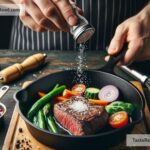The Science of Cooking with Chemical Processes: Techniques and Tips
Cooking isn’t just about following recipes—it’s also about science! Every time you cook, you’re creating chemical reactions. From boiling pasta to baking cakes, science is what transforms raw ingredients into delicious dishes. Understanding the science behind cooking can help you become a better cook. Plus, it’s fascinating! Let’s explore the chemical processes involved in cooking and learn some tips for improving your culinary skills.
What Is the Science Behind Cooking?
Science plays a big role in cooking. When heat, cold, or mixing happens, chemical changes occur. These changes can affect the texture, taste, and look of food. Here are some common processes:
-
Maillard Reaction
Ever wonder why grilled steaks or toasted bread taste so good? That’s thanks to the Maillard reaction. When heat meets protein and sugar, they break down and react to form new flavors and aromas. That browning on your steak or cookies? It’s science! -
Caramelization
Caramelization happens when sugar is heated. It’s why onions turn golden when you cook them or why desserts taste richer when sugar is melted. Heat breaks sugar molecules apart, creating sweet and complex flavors. -
Protein Denaturation
Proteins are like tightly coiled ropes. Heat, acid, or mixing can unravel them. This is why eggs firm up when cooked—they’re undergoing protein denaturation. It’s also why lemon juice can “cook” fish in dishes like ceviche. -
Fermentation
Fermentation relies on microbes like yeast or bacteria to create chemical reactions. It’s responsible for bread rising, yogurt thickening, and wine and beer bubbling. Fermentation adds flavors and textures while preserving food. -
Emulsification
Ever mix oil and vinegar for a salad dressing, but they separate? That’s because oil and water don’t naturally mix. However, with emulsifiers like mustard or egg yolks, you can blend them together. Emulsification is key to creamy mayo and smooth sauces.
Techniques for Understanding Cooking Science
Now that you know some chemical processes, here are techniques to help you use science while cooking:
-
Control Temperature
Temperature isn’t just about cooking food thoroughly. It affects flavor and texture. For example, searing meat at high heat creates the Maillard reaction, giving it a golden crust. Baking at low temperatures makes cookies soft, while high temperatures make them crispy. Use a thermometer to ensure accuracy, especially for meats and sweets. -
Mix Ingredients Wisely
Mixing causes chemical reactions. For cakes, overmixing flour activates too much gluten, making them dense instead of fluffy. For delicate recipes, follow instructions carefully to avoid overmixing. -
Use Acids for Flavor and Texture
Acids like lemon juice, vinegar, or buttermilk are powerful tools in cooking. They can tenderize tough meat, brighten flavors, and even “cook” food (like in ceviche). Adding acidic ingredients changes the chemical structure of food, making it more vibrant and tender. -
Master Baking Chemistry
Baking is pure science—it’s chemistry in action! The ingredients must be balanced for the right chemical reactions. Baking soda and baking powder create bubbles that make cakes and bread rise. Butter adds moisture, while eggs provide structure. To bake successfully, measure carefully and follow recipes closely. -
Experiment with Fat and Oil
Fats add flavor and help with heat transfer. For example, frying uses oil to crisp up food. Butter adds richness, while olive oil creates smooth spreads. If your dish seems dry or dull, a small amount of fat can make it better. -
Understand Frozen Foods
Freezing isn’t just about preserving food—it also causes chemical changes. Ice crystals form, affecting texture. For example, freezing fruit makes it mushy because water inside expands. To avoid freezer burn, use airtight containers to block air exposure.
Tips for Using Science in Everyday Cooking
Cooking with science doesn’t require fancy equipment. Here are some useful tips:
-
Preheat Your Pan or Oven: Heat creates chemical reactions. Starting with a preheated pan ensures food cooks evenly and faster.
-
Rest Your Meat: After cooking, let meat “rest” for a few minutes. This allows juices to redistribute, making it tender and juicy.
-
Use Salt Strategically: Salt draws moisture out of food and enhances flavor. For crispy potatoes, salt them before cooking. For soups, salt gradually to avoid oversalting.
-
Make Creamy Sauces with Emulsifiers: Add mustard or egg yolk to make creamy dressings or sauces without separating.
-
Experiment Safely: Cooking is science, but it’s also fun! Try different ingredients and methods, but be mindful of food safety principles.
Why Cooking Science Matters
Understanding the science behind cooking can make you a smarter cook. It explains why certain techniques work and why others fail. Plus, it can help you troubleshoot issues. Did your cake collapse? Maybe you didn’t mix your leavening agent properly. Is your steak tough? Perhaps you overcooked it and broke down the proteins too much.
Science can also inspire creativity in the kitchen. Try caramelizing fruits for dessert or using emulsifiers to create unique dressings. The more you experiment, the more you’ll realize how fascinating cooking science truly is.
Final Thoughts
Cooking is full of chemical processes that affect how food tastes, feels, and looks. By understanding the science of cooking, you can improve your skills and make tastier meals. Remember, cooking isn’t just about recipes—it’s also about experimenting with heat, mixing, and ingredients. The next time you’re in the kitchen, think about the chemical reactions happening in your food—you might see your meal in a whole new light!

